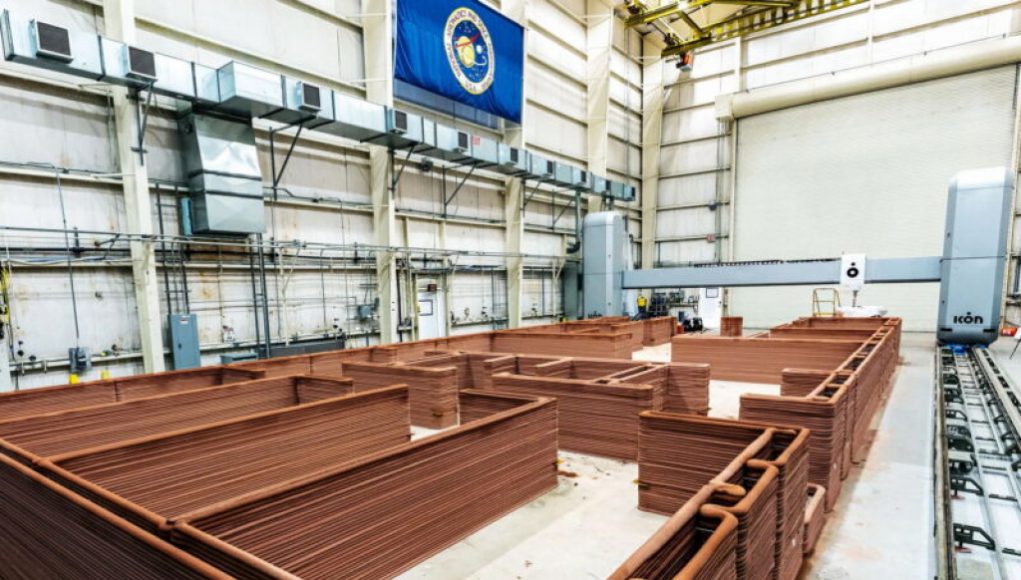Get ready for a groundbreaking experiment! In June, a four-person crew will enter a 3D-printed building at NASA’s Johnson Space Center in Houston, Texas, and spend a year inside. The building, called Mars Dune Alpha, was designed by BIG-Bjarke Ingels Group and 3D printed by Icon Technology using a slurry that looked like soft-serve ice cream before it dried. The 1,700-square-foot space has crew quarters, shared living space, and dedicated areas for medical care and growing food. But this isn’t just any experiment – it’s the first structure built for a NASA mission by the Moon to Mars Planetary Autonomous Construction Technology (MMPACT) team. The team is preparing for the first construction projects on a planetary body beyond Earth, and they’re starting with the Moon.
The MMPACT team is working on sustainable, long-lasting structures that use the regolith already on the Moon. They plan to turn the regolith into a paste that can be 3D printed into thin layers or different shapes. The team’s first off-planet project is tentatively scheduled for late 2027. For that mission, a robotic arm with an excavator will sort and stack regolith, attached to the side of a lunar lander. Subsequent missions will focus on using semiautonomous excavators and other machines to build living quarters, roads, greenhouses, power plants, and blast shields that will surround rocket launch pads.
But there are challenges to overcome. One of the biggest challenges is making the lunar regolith into a building material strong enough and durable enough to protect human life. The regolith could contain ice, and NASA only has samples from the Apollo 16 mission to experiment with. So the MMPACT team has to make their own synthetic versions. They keep buckets in their office of about a dozen combinations of what NASA expects to find on the Moon. The recipes include varying mixtures of basalt, calcium, iron, magnesium, and a mineral named anorthite that doesn’t occur naturally on Earth.
Building on the Moon has other challenges too. Gravity is much weaker, there’s a chance of moonquakes that can create vibrations for up to 45 minutes, and temperatures at the south pole can get as high as 130° Fahrenheit in sunlight and as low as –400° at night. Abrasive moon dust can clog machinery joints and bring hardware to a screeching halt. During the Apollo missions, regolith damaged space suits, and inhaling dust caused astronauts to experience hay-fever-like symptoms.
Despite the challenges, the MMPACT team is determined to make construction on the Moon as autonomous as possible. They plan to use lasers or microwaves to melt regolith, then cool it to allow gases to escape before printing it into desired shapes. The team feels that they can do a “reasonably good job” of matching the geochemical properties of the regolith, but making the geotechnical properties is much harder.
The MMPACT team is paving the way for humanity’s return to the Moon as part of NASA’s Artemis program. Astronauts will first live in places like an orbiting space station, on a lunar lander, or in inflatable surface habitats. But the MMPACT team is preparing for the construction of sustainable, long-lasting structures. Who knows what the future holds? Maybe one day, we’ll be living on the Moon!
NASA has recently released its new strategy titled, “Space Exploration Strategy to Melt the Moon and Construct on Mars,” outlining its objectives for the future of space exploration. The strategy details the agency’s plan to use cutting-edge research and technology to help extend human presence beyond Earth.
NASA plans to utilize its resources and develop new technologies to extract materials from the moon’s frozen water reserves and melt them into liquid form. This liquid would then be used to make materials and fuel for future space exploration, including constructing necessary support systems and habitats on Mars.
The technology being developed for this space exploration mission includes advanced solar-powered equipment designed to convert the frozen water into liquid. Additionally, thermal-optic mirrors will be developed to focus the sun’s energy on a given area on the moon and help speed up the melting process.
Unfortunately, this process of melting the moon is still in its infancy. The technology and strategies needed for this type of mission must be improved and tested before the venture can proceed. Meanwhile, research and technology developments related to constructing habitats and support systems on Mars are advancing at a steady rate as the mission objectives become more clearly defined and realized.
The strategy released by NASA will be used to help create a roadmap for the future of space exploration to Mars and beyond. The agency is confident that with the right resources and technology, that human presence can be extended beyond our own solar system.
NASA is committed to maximizing its influence in space exploration, and the strategy released is a testament to that dedication. From extracting resources from the moon to building habitats on Mars, this strategy serves as a bold and innovative plan for the agency’s future.




















